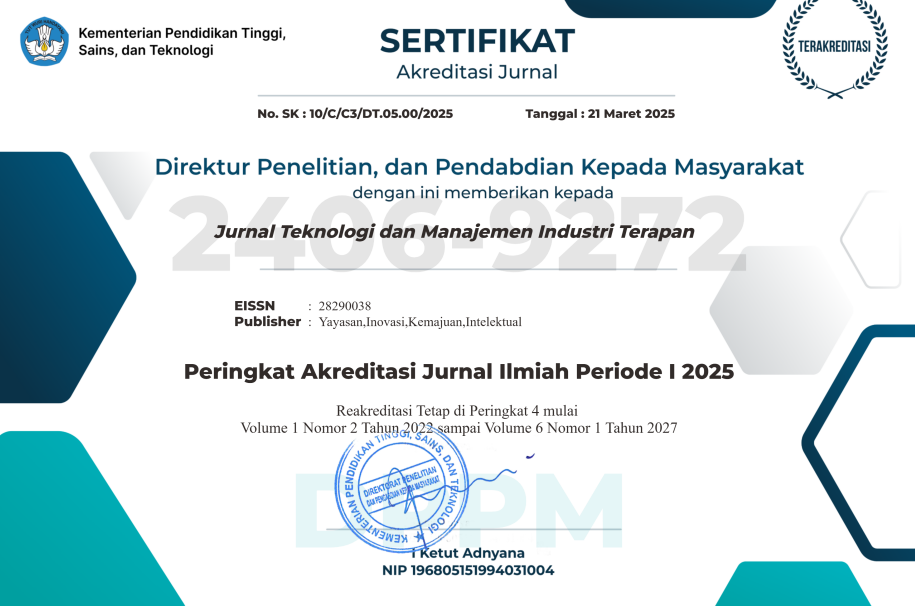Analisis Stabilitas Lereng Pada Ruas Jalan Nasional Timor Raya Km. 43+300 Dengan Perkuatan Bored Pile
DOI:
https://doi.org/10.55826/z3ak9a96Keywords:
Landslide, Slope Stability, Bored PileAbstract
Ruas Jalan Nasional Oesao - Bokong khususnya pada STA 43+300 yang letaknya berdekatan dengan anak sungai, senantiasa menghadapi permasalahan teknis berupa kerusakan perkerasan jalan aspal yang ditandai dengan terjadinya retak memanjang, bergelombang pada permukaan jalan dan longsor pada permukaan jalan. Data dari Satuan Kerja Perencanaan dan Pengawasan Jalan Nasional Provinsi Nusa Tenggara Timur, paket penanganan longsor Camplong, STA 43+300, ruas Oesao - Bokong, Pada bulan Oktober 2018, terjadi longsor dan menyebabkan amblesan sebagian badan jalan dan bahu jalan dengan panjang longsor kurang lebih 100 meter. Penanganan yang dilakukan adalah pemasangan gabion. Pada tahun 2022, permukaan jalan kembali ambles sejauh 40 meter dan beda elevasi berkurang kurang lebih 20 cm. Mitigasi longsor dengan menggunakan gabion belum efektif dalam menanggulangi permasalahan longsor yang terjadi di Jalan Nasional Oesao-Bokong khususnya pada STA 43+300. Berdasarkan kajian penanganan longsor, beberapa metode dapat digunakan untuk mitigasi potensi longsor pada lereng, salah satunya adalah penggunaan tiang bor. Tiang bor digunakan sebagai penahan geser apabila dinding penahan saja tidak mampu menahan tekanan tanah lateral. Tiang bor juga dapat memberikan daya dukung yang lebih efektif. Hasil kajian penanganan ruas jalan Timor Raya KM 43+300 dengan Perkuatan Tiang Bor menunjukkan bahwa penyebab longsor yang terjadi pada ruas jalan Nasional Oesao – Bokong STA. 43+300 adalah geometri lereng yang tidak stabil, penurunan tanah pada tanggul yang kurang rapat, limpasan air sehingga terjadi rembesan yang membentuk aliran akibat curah hujan yang tinggi menyebabkan lereng dalam kondisi jenuh dan adanya gaya luar yang mempengaruhi kestabilan lereng yaitu beban kendaraan. Analisis lereng menggunakan pemodelan alternatif 4 dengan menggunakan Software Geo5 menghasilkan faktor keamanan (SF) sebesar 1,30 dengan menggunakan tiang bor berdiameter 50 cm dan kedalaman 8 meter serta jarak antar tiang 1,2 meter.
References
[1] J. j.Zhou, “Field tests on behavior of pre-bored grouted planted pile and bored pile embedded in deep soft clay,” Soils and Foundations, vol. 60, no. 2, pp. 551–561, 2020, doi: 10.1016/j.sandf.2020.03.013.
[2] J. j.Zhou, “Field behavior of pre-bored grouted planted nodular pile embedded in deep clayey soil,” Acta Geotechnica, vol. 15, no. 7, pp. 1847–1857, 2020, doi: 10.1007/s11440-019-00891-x.
[3] J. j.Zhou, “Field study on the behavior of pre-bored grouted planted pile with enlarged grout base,” Acta Geotechnica, vol. 16, no. 10, pp. 3327–3338, 2021, doi: 10.1007/s11440-021-01208-7.
[4] M. E.Al‐atroush, “Behavior of a large diameter bored pile in drained and undrained conditions: Comparative analysis,” Geosciences Switzerland, vol. 10, no. 7, pp. 1–19, 2020, doi: 10.3390/geosciences10070261.
[5] X.Zhao, “Load-bearing performance of caisson-bored pile composite anchorage foundation for long-span suspension bridge: 1-g model tests,” Acta Geotechnica, vol. 18, no. 7, pp. 3743–3763, 2023, doi: 10.1007/s11440-023-01808-5.
[6] H.Zhao, “Vertical Load Transfer for Bored Piles Buried in Cohesive Intermediate Geomaterials,” International Journal of Geomechanics, vol. 20, no. 10, 2020, doi: 10.1061/(ASCE)GM.1943-5622.0001810.
[7] Y. H.Ong, “Bored piles in tropical soils and rocks: Shaft and base resistances, t-z and q-w models,” Proceedings of the Institution of Civil Engineers Geotechnical Engineering, vol. 174, no. 2, pp. 193–224, 2021, doi: 10.1680/jgeen.19.00106.
[8] T.Hu, “Full-scale tests on the grouting effectiveness of offshore bored piles with various bearing strata,” Applied Ocean Research, vol. 141, 2023, doi: 10.1016/j.apor.2023.103791.
[9] X.Zhao, “Caisson-Bored Pile Composite Anchorage Foundation for Long-Span Suspension Bridge: Feasibility Study and Parametric Analysis,” Journal of Bridge Engineering, vol. 27, no. 12, 2022, doi: 10.1061/(ASCE)BE.1943-5592.0001969.
[10] Y. C.Yu, “Numerical simulation and field tests on vertical load bearing behaviour of bored root piles,” Computers and Geotechnics, vol. 159, 2023, doi: 10.1016/j.compgeo.2023.105453.
[11] T.Hu, “Field study of the effects of composite excavation and combined grouting on the response of large-diameter and superlong rock-socketed bored piles,” Acta Geotechnica, vol. 19, no. 4, pp. 1853–1871, 2024, doi: 10.1007/s11440-023-02021-0.
[12] Z.Zhou, “Application of load transfer method for bored pile in loess area,” European Journal of Environmental and Civil Engineering, vol. 26, no. 10, pp. 4457–4475, 2022, doi: 10.1080/19648189.2020.1854125.
[13] M.Tang, “The Vertical Bearing Mechanism of Hybrid Bored Pre-stressed Concrete Cased Piles,” International Journal of Civil Engineering, vol. 18, no. 3, pp. 293–302, 2020, doi: 10.1007/s40999-019-00466-7.
[14] Y. l.Cui, “Field test research on post-grouting effect for super-long cast-in-place bored pile in thick soft foundation,” Geotechnical and Geological Engineering, vol. 39, no. 7, pp. 4833–4842, 2021, doi: 10.1007/s10706-021-01796-x.
[15] J. l.Yu, “The frictional capacity of smooth concrete pipe pile–cemented soil interface for pre-bored grouted planted pile,” Acta Geotechnica, vol. 18, no. 8, pp. 4207–4218, 2023, doi: 10.1007/s11440-023-01842-3.
[16] Y.Xu, “Experimental study on long-term bearing behaviors of base post-grouting bored piles,” Jianzhu Jiegou Xuebao Journal of Building Structures, vol. 42, no. 4, pp. 139–146, 2021, doi: 10.14006/j.jzjgxb.2020.C299.
[17] L.Gao, “Experimental Study of Deformation Measurement of Bored Pile Using OFDR and BOTDR Joint Optical Fiber Sensing Technology,” Sustainability Switzerland, vol. 14, no. 24, 2022, doi: 10.3390/su142416557.
[18] S.Alzabeebee, “Development of an optimized model to compute the undrained shaft friction adhesion factor of bored piles,” Geomechanics and Engineering, vol. 28, no. 4, pp. 397–404, 2022, doi: 10.12989/gae.2022.28.4.397.
[19] X.Zheng, “Evaluating the effect of post-grouting on long bored pile based on ultra-weak fiber Bragg grating array,” Measurement Journal of the International Measurement Confederation, vol. 214, 2023, doi: 10.1016/j.measurement.2023.112743.
[20] A.Oteuil, “Robust Analysis and Design of Bored Pile Considering Uncertain Parameters,” Indian Geotechnical Journal, vol. 52, no. 3, pp. 720–734, 2022, doi: 10.1007/s40098-021-00588-7.
[21] Y.Zhang, “Identification of bored pile defects utilizing torsional low strain integrity test: Theoretical basis and numerical analysis,” Journal of Rock Mechanics and Geotechnical Engineering, vol. 17, no. 5, pp. 3035–3053, 2025, doi: 10.1016/j.jrmge.2024.08.021.
[22] Y.Wu, “Effect of grout conditions on the mechanical behaviors of unloading sand-concrete interface for reinforcing bored pile foundation,” Construction and Building Materials, vol. 243, 2020, doi: 10.1016/j.conbuildmat.2020.118218.
[23] V. H.Huynh, “A novel direct SPT method to accurately estimate ultimate axial bearing capacity of bored PHC nodular piles with 81 case studies in Vietnam,” Soils and Foundations, vol. 62, no. 4, 2022, doi: 10.1016/j.sandf.2022.101163.
[24] B. T.Pham, “Estimation of ultimate bearing capacity of bored piles using machine learning models,” Vietnam Journal of Earth Sciences, vol. 44, no. 4, 2022, doi: 10.15625/2615-9783/17177.
[25] Q. q.Zhang, “Behaviour analysis on the vertically loaded bored pile socketed into weak rocks using slip-line theory arc failure surface,” Computers and Geotechnics, vol. 128, 2020, doi: 10.1016/j.compgeo.2020.103852.
Downloads
Published
Issue
Section
License
Copyright (c) 2025 Welem MWL Daga, Yermias E. Lay, Joko Suparmanto, Indradhi Lasmana, Michael F. Milla

This work is licensed under a Creative Commons Attribution-NonCommercial-ShareAlike 4.0 International License.


















